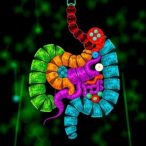
In a groundbreaking study published today in Nature Cancer, researchers from St. Jude Children’s Research Hospital and University Health Network’s Princess Margaret Cancer Centre in Toronto have uncovered critical insights into how the developmental stage of B cells at the onset of leukemia influences treatment outcomes in pediatric B-cell acute lymphoblastic leukemia (B-ALL). This work not only deepens our understanding of the cellular origins of leukemia but also paves the way for novel strategies in risk stratification and therapeutic targeting.
Charles Mullighan, deputy director of the St. Jude Comprehensive Cancer Center and corresponding author of the study, explains that their approach leveraged large genomic datasets integrated with clinical outcomes to connect the biological state of leukemic cells to their behavior under therapy. “We took single-cell sequencing data and mapped it onto a detailed reference atlas of normal B-cell development,” Mullighan says. “This allowed us to pinpoint exactly where in the hematopoietic pathway malignant transformation occurs and how it correlates with treatment resistance.”
To achieve this mapping, the team collaborated with John Dick, a senior scientist specializing in stem cell biology. They focused on constructing a comprehensive single-cell atlas of human hematopoiesis with a particular emphasis on B cell lineage differentiation, a process that had previously lacked detailed characterization in humans. This atlas served as a scaffold to locate the precise developmental stages at which leukemic cells deviate from normal maturation pathways.
.adsslot_VxOIzfS3Tv{ width:728px !important; height:90px !important; }
@media (max-width:1199px) { .adsslot_VxOIzfS3Tv{ width:468px !important; height:60px !important; } }
@media (max-width:767px) { .adsslot_VxOIzfS3Tv{ width:320px !important; height:50px !important; } }
ADVERTISEMENT
The prevailing dogma suggested that B-ALL originates predominantly from cells arrested between the pro-B and pre-B stages. However, the team’s data revealed a far broader heterogeneity. Some leukemias arise from more immature progenitors exhibiting multipotent characteristics, while others originate from cells further along the B-cell developmental trajectory. This discovery challenges existing concepts and emphasizes the importance of cellular context in leukemia pathogenesis.
One striking finding of the study is the identification of leukemic cells at early hematopoietic progenitor stages that retain the ability to switch lineage fates. Typically, progenitor cells committed to the lymphoid lineage differentiate exclusively into lymphocytes. Yet, when the researchers cultured non-leukemic common lymphoid progenitor cells, they observed unexpected plasticity as these cells adopted characteristics of the myeloid lineage, indicating latent developmental flexibility.
This ability for lineage switching has profound clinical implications. It suggests a potential mechanism for treatment evasion, where leukemic cells can “escape” targeted therapies by altering their identity and thereby circumventing drugs designed for a specific cellular subset. Understanding this plasticity could be key to overcoming therapeutic resistance that limits remission durability in pediatric B-ALL.
Leveraging this biological insight, the researchers developed a novel “multipotency score” capable of quantifying the degree of developmental arrest and plasticity within leukemic populations. Tested on independent patient cohorts, this score demonstrated remarkable predictive power for clinical outcomes, offering a promising biomarker for identifying patients at higher risk for poor response or relapse.
The study also exemplifies the power of integrating multi-layered data—combining single-cell genomics, developmental biology, and clinical metadata—to dissect the complexities of cancer biology at unprecedented resolution. This integrative approach may serve as a model for future investigations across a range of hematological malignancies and other cancers.
Importantly, these findings suggest the potential for more personalized therapeutic approaches in pediatric B-ALL. Subtypes defined not solely by genetic mutations but by their developmental lineage characteristics and plasticity profiles could inform treatment selection, intensification, or the use of novel agents designed to target multipotent or lineage-flexible leukemic cells.
John Dick emphasizes the translational significance: “By anchoring leukemia subtypes to distinct points along the human hematopoietic pathway, we open new avenues for developing precision medicine strategies that address the biological underpinnings of treatment resistance.” This refined understanding of B-cell ontogeny in leukemia advances both diagnostic accuracy and therapeutic innovation.
The extensive collaboration involved numerous co-authors across institutions including St. Jude, Princess Margaret Cancer Centre, University of Toronto, and prominent medical centers across North America. The interdisciplinary nature of the team highlights the importance of combining expertise in pathology, genomics, stem cell biology, and clinical oncology to confront complex disease mechanisms.
Funding for this research encompassed a wide array of national and international grants, reflecting the global commitment to childhood cancer research. Resources from entities like the National Cancer Institute, Alex’s Lemonade Stand Foundation, and the Canadian Institutes for Health Research were instrumental in supporting the advanced technologies and patient cohorts leveraged in the study.
St. Jude Children’s Research Hospital continues to lead innovations in pediatric oncology, with a mission centered on transforming the treatment and cure rates of childhood cancers. This study underscores St. Jude’s dedication to pushing the boundaries of scientific knowledge toward better outcomes for children worldwide afflicted by devastating diseases like B-ALL.
By constructing a detailed map of human B-cell development and applying it to leukemia biology, this research delineates not only the cellular origins of B-ALL but also illuminates the dynamic behaviors that contribute to therapy failure. The “multipotency score” stands out as a promising tool for clinicians and scientists alike, potentially heralding a new era of precision diagnostics and personalized interventions in pediatric leukemia.
Subject of Research: B-cell acute lymphoblastic leukemia (B-ALL), hematopoiesis, leukemia cell developmental origins, treatment outcomes
Article Title: Multipotent lineage potential in B cell acute lymphoblastic leukemia is associated with distinct cellular origins and clinical features
News Publication Date: 27-Jun-2025
Web References:
Nature Cancer article
St. Jude Children’s Research Hospital
Image Credits: St. Jude Children’s Research Hospital
Keywords: Leukemia, Lymphocytes, Pediatrics, Drug resistance, Hematopoiesis, Cell pathology
Tags: B-cell development leukemia treatmentcellular origins of leukemiacomprehensive single-cell atlas hematopoiesisgenomic datasets leukemia researchhematopoietic pathway malignant transformationJohn Dick stem cell biologypediatric B-cell acute lymphoblastic leukemiarisk stratification leukemiasingle-cell sequencing B-cellsSt. Jude Children’s Research Hospital studytherapeutic targeting B-ALLtreatment outcomes leukemia



